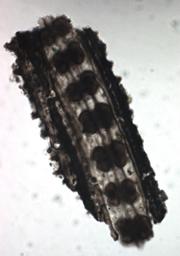 Microscopic pieces of silica in fossilised dinosaur droppings show that they ate grass.© Science
Microscopic pieces of silica in fossilised dinosaur droppings show that they ate grass.© ScienceSome piles of fossilized dinosaur dung in India have revealed a surprising fact: some dinosaurs ate grass.
Although grasses are dominant in habitats across the world today, they weren't thought to exist until some ten million years after the age of dinosaurs had ended. Dinosaurs ruled between 275 and 65 million years ago, but the earliest verified grass fossils are from about 55 million years ago. The two were never thought to have met.
But the discovery of silica structures characteristic of grass in fossilized dinosaur droppings show that they did. Caroline Strömberg, a palaeobotanist at the Swedish Museum of Natural History, Stockholm, and her colleagues based in India found signs of a variety of grass species in the dung, they report in the journal Science1.
The team collected 65-million-year-old droppings from the volcanic Deccan Traps of central India in order to study the diet of titanosaurs, the group of super-size dinosaurs that includes Diplodocus.
They then ground up the pieces of fossilized dung, known as coprolites, and looked for phytoliths, microscopic pieces of silica from plant cells. They expected to find evidence of well-known Late Cretaceous vegetation such as conifers and cycads. But they also came across some phytoliths that could only have come from grass.
"It was very unexpected," says Strömberg. She says their findings shake up what was known about grass. "We will have to rewrite our understanding of its evolution," she says. "We may have to add grass to the dioramas of dinosaurs we see in museums."
Grass grazers
Experts have long thought that grass evolved alongside mammalian grazers such as horses, camels and rhinos. Once grazers were around, grass would have had a significant advantage over other plants. Because grass shoots straight from the ground, it isn't killed when its top is munched away. And it contains a lot of hard phytoliths, as a defence against hungry jaws.
Now it seems that dinosaurs or other early mammals may have been the early grazers that gave grass a head start. Dinosaurs probably contributed minimally to this, Stromberg says: they mainly had the wrong kind of teeth for ripping up grass, and the titanosaur coprolites indicate that grass was only a small part of their diet. The best candidate is instead probably a class of mammals called the gondwanatherians. "They have extremely tall teeth that look very much like the teeth of horses or other grazers," says Strömberg.
ADVERTISEMENT
It may still prove that grass was too rare 65 million years ago to be a major food source for gondwanatherians either. They may instead have used their long teeth to dig and chop, in the same way that beavers do, says Paul Barrett, a dinosaur expert at the Natural History Museum, London. After all, he points out, widespread grasslands didn't appear until about 25 million years ago, so they couldn't have been that great a food source during the age of the dinosaurs.
Regardless of which creatures were munching on the ancient grasslands, the new finding is of real interest to paleaobotanists. And it just goes to show how useful coprolites can be. "People generally overlook them," says Barrett. "It's not good dinner party conversation to say you work on fossilized dinosaur turds, but they are the best way to find out what dinosaurs ate."
